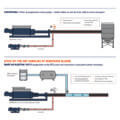There are some things that are obvious in business; for instance, maximising profit by reducing costs and increasing sales. Is rightshoring an example of this, or is it a concept that requires a pioneer? Neil Ballinger, head of EMEA at global automation parts supplier EU Automation explains all.
As well as obvious ideas, there are also theories that only become self-evident once a pioneering thinker has made them so, such as Henry Ford’s development of assembly line mass production or Masaaki Imai’s introduction of the concept of Kaizan.

It would now seem insane to structure a manufacturing plant as a series of single cells in which specialist artisans produce an entire product, irrespective of how many parts or steps are required to make it. Similarly, it would seem crazy to not focus on your process, introducing incremental improvements regularly to help achieve a better result.
But before Ford and Imai, these were both standard practices.
Rightshoring seems like an obvious idea; put each component or process in your business in a country or locality that offers the optimal combination of output quality versus cost. However, when businesses began offshoring, this is exactly what they thought they were doing, and many were. It was only later that they discovered that distance could create a trade off in quality that didn’t compensate for lower cost.
When industry began to re-shore it was on the same quest for best quality and lowest cost; or at least it thought so. As it discovered that offshoring creates a natural evolutionary process of cost increases in the locations you choose, many companies re-evaluated the output quality versus cost matrix, and concluded that expenses had risen sufficiently in the offshored locales that it made sense to put everything back where it was to start with.
Enter reshoring
In the first half of the last decade, between 2010 and 2015, one in six British manufacturers re-shored some part of their production. Many of these businesses, including Barbour, Burberry and Mulberry made luxury items, which had a significant ‘made-in’ element to the brand.
In a paper published by Springer Link back in 2016, called Reshoring: a strategic renewal of luxury clothing supply chains, Pamela Robinson argued that:
“The renewal of supply chain strategy and the appropriateness of reshoring has increased for luxury branded goods where efficacy and authenticity of the brand have become a consumer-driven requirement. This is particularly pertinent for firms wishing to ensure the provenance of their product proposition and maintain comparative advantage in a highly competitive market sector.”
In other words, many businesses used the Made in Great Britain, Made in Germany, and Made in France phrases et al,as a justification for reshoring. It’s as if provenance itself presented as obvious a business case as profit. The trouble is, there is no concrete evidence that the ‘made in’ tag adds to the top line – or the bottom one.
Enter rightshoring
To paraphrase Shakespeare’s most famous stage instruction, from A Winter’s Tale, at this point we see rightshoring enter stage right, pursued by a bear — although in this case a bear market. As manufacturing businesses began to weary of the costs associated with moving from one location to another, chasing a mythical cheap which it might never catch, the market for off-or-reshoring began to decline.
For instance, in 2000, Chinese workers averaged 52 cents an hour, but since then wages and benefits have risen by double digits each year, including an average of 19 per cent from 2005 to 2010. The cost increases in the US and European markets have been a fraction of that — because China has levelled up.
As a result, the idea of rightshoring became popular, and yet it is still without a pioneer in manufacturing; there is no Henry Ford or Masaaki Imai demonstrating its unquestionable benefits. This is despite the fundamental truth that the weight of raw materials, and thus their shipping costs, can be one of the biggest factors in the equation that determines the ‘right’ location.
However, there are pioneers in other industries from which we might draw inspiration. In 2008, Capgemini France filed a trademark on the word ‘Rightshore’, describing its process of streamlining costs and improving innovation through global delivery and outsourcing. Similarly, the financial industry, offering a service with no raw materials requirement, has made rightshoring a success.
At EU Automation we have always used a global network of hundreds of suppliers to source automation parts for our customers at the best price, as quickly as possible and in the right location to increase delivery speed and reduce shipping costs. Over the last five years we have also added facilities in Germany, the US, Singapore and the UK to further our ability to serve any enquiry from the right location.
Is rightshoring obvious? I think it is, by definition, but perhaps some inspiration could be drawn from Imai’s philosophy of Kaizen, which is “that not a day should go by without some kind of improvement being made somewhere in the company.”
Given manufacturing’s history of off-re-and-rightshoring it would be wise to consider those daily decisions in the context of historic and predicted market changes, otherwise it might quickly find that the right choice once more becomes the wrong one.








